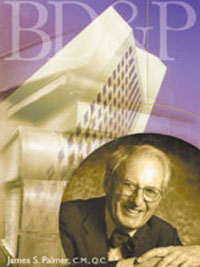A recent oil patch merger is representative of the lay of the land in Calgary’s legal marketplace. In August, Talisman Energy Inc. made an offer for all the shares of Rigel Energy Corporation in a friendly deal valued at $1.2 billion. The three law firms involved were Bennett Jones (for Talisman), Macleod Dixon (for Rigel) and Burnet, Duckworth & Palmer (BD&P) (for Rigel’s Special Committee of the Board of Directors). At least one or more of these three law firms seems to be sitting at the table on almost every significant Alberta-based deal these days.
Bennett Jones always has been the acknowledged market leader. Macleod Dixon has been closing the gap successfully over a number of years, particularly with the addition of 17 business lawyers this year from the disbanded firm of MacKimmie Matthews. Ten years ago, however, BD&P had its elbows up with the rest of the pack of firms chasing a greater share of the high-end corporate work in Calgary. That pack currently includes Fraser Milner and the other four national firms with Calgary offices (i.e., Blakes, McCarthys, Oslers and Stikemans), each of which lands high-profile work. At 82 lawyers, BD&P is about half the size of Bennett Jones (170 lawyers in Calgary) and Macleod Dixon (148 lawyers in Calgary). In fact, the firm is not much bigger than it was in the early 1980s.
So what’s changed? Why is BD&P’s star rising and its market share expanding? Harry Campbell, chairman of BD&P’s executive committee, has an explanation. “We have 15 partners between 35 and 45 (years of age) who have hit their stride in the last five to eight years, which has been very good for the firm.” Indeed, last year, Lexpert recognized 20 of the firm’s 40 partners as leading practitioners in their respective areas of practice.
BD&P is an “aggressive, creative law firm,” says Brett Wilson, the managing director and COO of First Energy Capital Corp. and a client of the firm. “The firm is unusual in the Calgary market in terms of attention to clients. They are just as competent (as the other leading firms) and often provide a higher level of service.” Bruce Chernoff, another client of the firm and former executive vice-president and CFO of Pacalta Resources, sings similar praises. “They key right into our needs. They don’t get lost in details. They’re very businesslike. I haven’t run across anyone who is better—that’s for sure.”
A critical mass of young partners “hitting their stride,” does not emerge overnight. A closer look at BD&P reveals several of the hallmarks of successful law firms: a strong market niche, loyal clients, loyal alumni, a culture of meritocracy, and strong leadership. Jim Palmer, Q.C., has provided that strong leadership since the firm began to grow in the 1960s. “Jim Palmer is one of the truly outstanding members of the legal profession in Canada. He is a great lawyer and widely sought after for business advice,” says Stephen Halperin, a leading corporate lawyer with Goodman Phillips & Vineberg, who was a partner at BD&P before moving to Toronto in 1987 for family reasons. Palmer has been a chairman of the Canadian Tax Foundation, a chancellor of the University of Calgary, and a former chairman of Telus Corporation. Still going strong at 70 years of age, he is a director of a dozen Canadian corporations, including the Canadian Broadcasting Corporation and Westcoast Energy Inc. Palmer is a “rainmaker par excellence,” says leading BD&P litigator David Haigh, Q.C. “He also has a great skill at attracting capable, smart people.”
BD&P always has had a depth of expertise in oil and gas and related practice areas of tax, securities, banking, insolvency, commercial litigation and real estate. The firm acts for a large number of intermediate and junior oil and gas producers as well as larger players, including Mobil Oil Canada and Renaissance Energy. BD&P was involved in three of the major offshore projects on the east coast, including Hibernia, Sable Island and the P.E.I. fixed link bridge. The firm also has been involved in most of the major Alberta-based insolvencies in the last decade, including, in the last year, Fracmaster, Blue Range Resource Corporation and Hurricane Hydrocarbons.
The secret of BD&P’s success, however, is the strong niche that it has carved for itself within the oil and gas market. The firm is known for its entrepreneurial client base and its knack for attracting start-up clients. By contrast, Bennett Jones is known for its blue-chip client base and its knack for attracting large foreign clients. One of BD&P’s start-up clients 20 years ago was Poco Petroleum Ltd., for whom they have acted ever since. On November 18, the shareholders of Poco will be asked to approve the takeover of the company by Houston-based Burlington Resources in a $3.5-billion negotiated deal. Bennett Jones has been acting for Burlington. Kevan King, general counsel of Poco, is a big fan of BD&P. “They are very business-minded and aware of the oil and gas business,” he says. “Their greatest strength is their ability to assist in making business decisions in the legal context.”
In the oil patch, start-ups are a renewable resource. Each time a big fish swallows a smaller fish, it coughs up the management team of the smaller fish. These management teams are free to start all over again—and usually do as soon as they can secure new properties. Unlike transactions in knowledge-based industries, it is rare to find management teams tied up as part of acquisitions of oil and gas properties. Pacalta Resources was a start-up client of BD&P in 1995 with a market capitalization of just $20 million. Last spring, Alberta Energy Company acquired the company in a hostile takeover for almost $1 billion. Bruce Chernoff and the former Pacalta management team have formed Caribou Capital Corp. to look for new opportunities.
Where does a law firm find start-ups? BD&P got its foot in the door with Peters & Co., a leading energy investment boutique. Jim Palmer explains: “Rob Peters started his company and soon after shifted a lot of work to us. We did all their underwritings—especially for smaller companies that grew. We met the issuers and others and (the work) grew from there.” History repeated itself in the 1990s when Brett Wilson was planning to launch an energy investment boutique. John Brussa, the leading tax partner at BD&P, ran into Wilson on the street and offered him the use of spare offices at the firm for a few months while Wilson and his partners got started. FirstEnergy Capital has become a powerhouse in the oil and gas market and a significant client. The firm regularly acts for most of the other investment banks in town as well.
Successful law firms often generate successful alumni who become loyal clients. BD&P’s most famous alumnus is financier Murray Edwards. A gold medallist, Edwards practised law “at a different level from the rest of us” says corporate partner Daryl Fridhandler, who started on the same day as Edwards. Edwards became a partner (the youngest ever at the time) and left in the late 1980s to invest long-term equity and time in turnaround opportunities. In just over a decade, Edwards has acquired interests in half a dozen companies that have grown significantly in terms of market capitalization. The flagship company in Edward’s group is Canadian Natural Resources; other companies include Penn West Petroleum, Rio Alto Exploration, Magellan Aerospace Corporation, Ensign Resource Services, and Imperial Metals. Many of these companies are now clients of BD&P. The 1999 Canadian Business ranking of the 100 richest Canadians estimated Edward’s net worth at $480 million.
Other important alumni of the firm include Mike Morin, general counsel of Mobil Oil Canada, and the late Bob Paget, who was one of the founders of Renaissance Energy, now one of Canada’s largest oil and gas producers. Loyal alumni can be helpful in ways other than as clients. Bill Maslechko was a young associate at Goodman Phillips & Vineberg in Toronto when he decided to move to Calgary in 1990 for family reasons. Maslechko is now a partner at BD&P and recognized as a rising M&A star in the legal community. But for the influence of Halperin, the alumnus who had joined Goodmans, Maslechko might have ended up at Bennett Jones or one of the other Calgary firms. Halperin also refers Alberta work to BD&P whenever he can.
The firm’s culture is a strong meritocracy. “Their entrepreneurial client base has bred an entrepreneurial group of lawyers—even by Calgary standards,” observes Halperin. They recently expanded onto a new floor in their office tower. The securities group moved in and decided that everyone—partners and associates—should have the same size office. Securities, in particular, is a practice area in which young lawyers can climb up the ladder of success quickly. Senior litigator David Haigh observes that “there is no limit to what a securities lawyer can do with eight or nine years of experience.” By contrast, he notes that “one is barely coming into one’s own as a litigation counsel at 10 years of experience.” Evidence of the meritocracy is the fact that two securities lawyers were made partner this year after only four and five years of practice, as opposed to the usual minimum of 6 years.
BD&P certainly has had success attracting capable, smart people. John Brussa, a gold medallist from Windsor law school, is one of those rare tax lawyers who doubles as a rainmaker. Halperin describes Brussa as “a lawyer of tremendous talent—one of the most creative tax guys I have ever come across.” Brussa has been practising for 18 years and he is only 42 years old. Another member of the critical mass of young partners “hitting their stride” is securities lawyer Grant Zawalsky. David Haigh recalls that “Grant was scary smart and self-confident as an articling student (in 1987). He hit the ground running, fully formed as a lawyer.” Clients agree. Bruce Chernoff declares that Zawalsky “probably doesn’t have an equal in the city (in the securities area).” Unprompted, Kevan King concurs that Zawalsky is “maybe the top securities lawyer in Calgary.”
Discover what does a securities lawyer do in Canada.
BD&P’s compensation system is “the antithesis of lockstep,” explains John Brussa. “A guiding principle (of Jim Palmer’s) has been to push money down to develop the practice. Junior partners can make a lot of money.” Harry Campbell notes that the system works because “the guys at the top are not greedy.” As Palmer explains, “It sounds corny when you say it, but we try to do good work above making money.”
BD&P’s meritocracy has a softer side, which it owes once again to Jim Palmer and other senior members. At one level, “there is a tolerance for different practice contributions,” notes Fridhandler. “Nobody makes me cut my hair,” quips Brussa. At another level, when asked what is most important about the culture at BD&P, Palmer replies that “everyone has dignity and you have to treat them with dignity.” Litigator Gina Ross remembers a telephone call from Palmer when she first joined the firm. “He wanted to get me involved in a matter. I said ‘I will be right up’. He said, ‘No, I am coming down to see you’.” The most important kind of leadership in a law firm is often leadership by example.
The two recipients of the Law Society of Alberta’s 1999 Distinguished Service Award for service to the community were both lawyers from BD&P: Jim Palmer and leading oil and gas lawyer John Cuthbertson, who was recognized for his involvement with Calgary Legal Guidance. Many of the firm’s lawyers are involved actively in community causes. It also regularly leads all Calgary law firms in raising money for the United Way.
Another indication that the firm’s star is rising is that they have not lost any lawyers in the “involuntary draft” to the new Calgary franchise of Donahue & Partners, the affiliated law firm of Ernst & Young. Both Bennett Jones and Macleod Dixon have been major donors to Donahue, which has recruited more than 20 lawyers from a standing start in less than one year.
While the legal landscape in Calgary may be stable at the end of 1999, the sands are constantly shifting on the oil patch. The Fraser Milner merger, the attempted merger of Bennett Jones with Tory Haythe, and the entry of Donahue, are all signs of a volatile market. Burnet, Duckworth & Palmer certainly would be an attractive merger partner for many firms outside the province. Right now, however, the firm is focused on its own backyard in the booming Calgary market. John Brussa sums up the firm’s strategic outlook when he says, “If the pond we swim in is healthy, we’ll be healthy.” Makes sense.
Timothy Leishman is a principal of Fraser Leishman, a Toronto-based consultancy with expertise in strategies for recruiting, retaining and accelerating the professional development of top talent in law firms.





